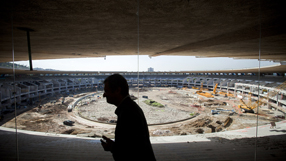
According to local tourist officials, it is the second most visited place in Brazil after the statue of Christ The Redeemer and on a par with the Sugar Loaf mountain.
But with the 2014 World Cup and Rio's 2016 Summer Olympics on the horizon, bulldozers, earthwork machinery, giant drilling equipment, cranes and a concentrated battalion of construction crew are feverishly working where once Pele and Garrincha displayed their sublime skills.
Like those Brazilian football gods, they too are striving to create something of memorable beauty.
The Maracana, famous for hosting the greatest crowd that ever watched a football match for the 1950 World Cup decider between Brazil and Uruguay is being completely transformed in advance of the 2014 World Cup finals, the first time the World Cup has returned to Brazil for what will be 64 years.
The stadium will also be a venue for Rio's Summer Olympics, but unlike Wembley Stadium, the world's other great football cathedral, which was completely demolished and rebuilt for the modern age between 2000 and 2007, the new Maracana will be enclosed within the outer shell of the old stadium.
Naturally, as there is with almost every stadium development the world over, there have been delays in the process.
But as Icaro Moreno Junior, the man responsible for overseeing the 931 million reais (US$595 million) project is delivered on time, told Reuters: "We will be ready.
The best features, fun and footballing quizzes, straight to your inbox every week.
"We cannot fail. And at the same time, we want to retain some of the past history of the Maracana, but we are also making something new.
"It is like a pie with a new filling. It is not a simple job, retaining something from the 1950s for the 21st century, but I am certain the new stadium will be special for Rio, for Brazil and for the whole world."
The Maracana holds attendance records that are unlikely ever to be broken. Some record books put the attendance for the 1950 final between Brazil and Uruguay as 205,000, others at 199,000 - no-one was ever certain then, and they aren't now.
What is certain is that the old stadium, built in the space of two years and first used for the 1950 finals, was a vast bowl, which regularly held crowds of over 150,000.
Not only does it hold the world's attendance record, but it also holds the record for a World Cup qualifying match when 162,764 saw Brazil play Colombia in 1977.
BRAND NEW
"Obviously the new capacity will be nothing like the old, but we will have 80,000 in a brand new stadium with state-of-the-art facilities, with a fabulous sound system, lighting, everything you see in a modern multi-purpose stadium," Moreno added.
"It will be an "intelligent" building, eco-friendly with no black spots or poor visibility for fans. Part of the challenge is to structurally recover part of the old building, some of the pillars which are now more than 60 years old and restore them for the next 50 years or more.
"At the moment we have 1,600 workers, but in a few months this will increase to
